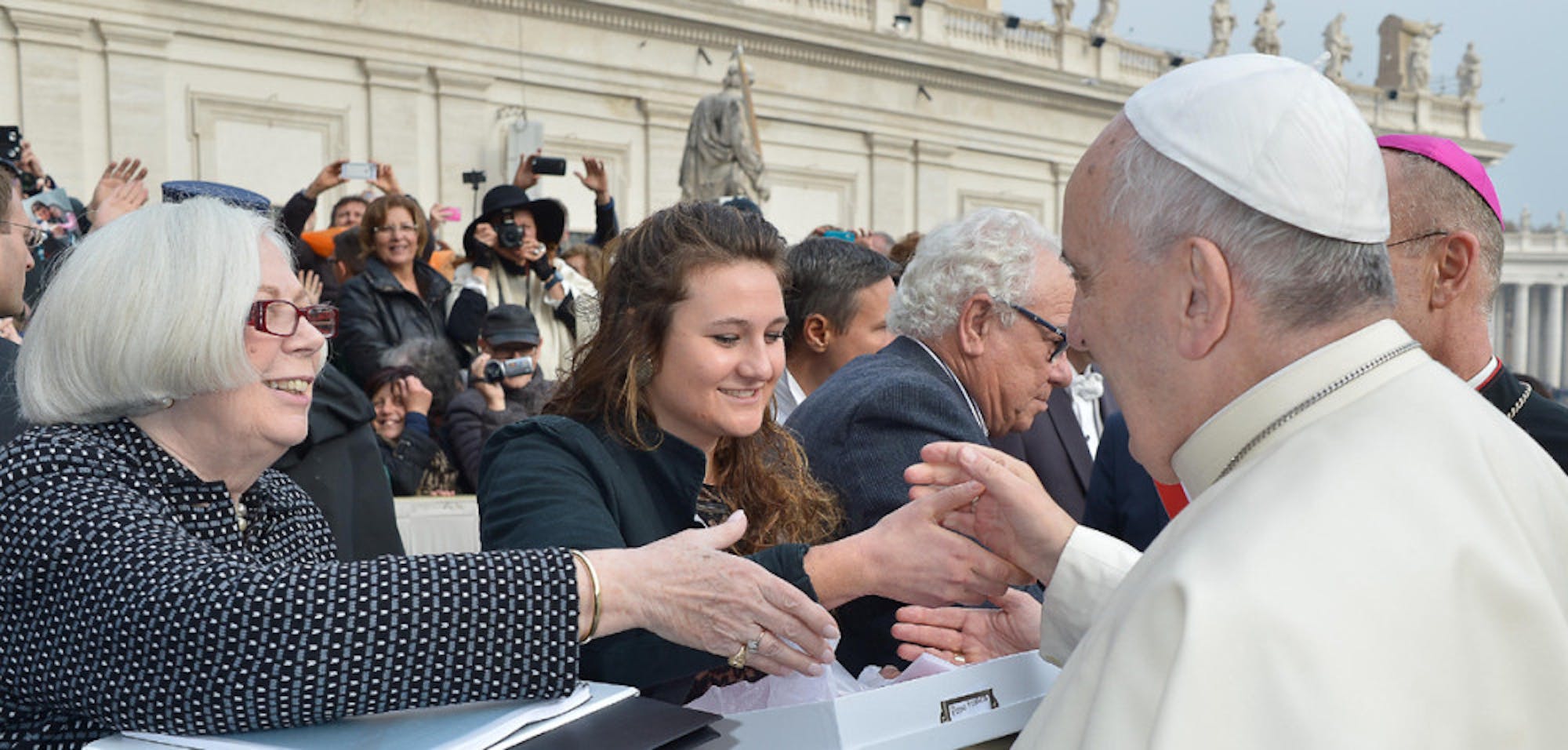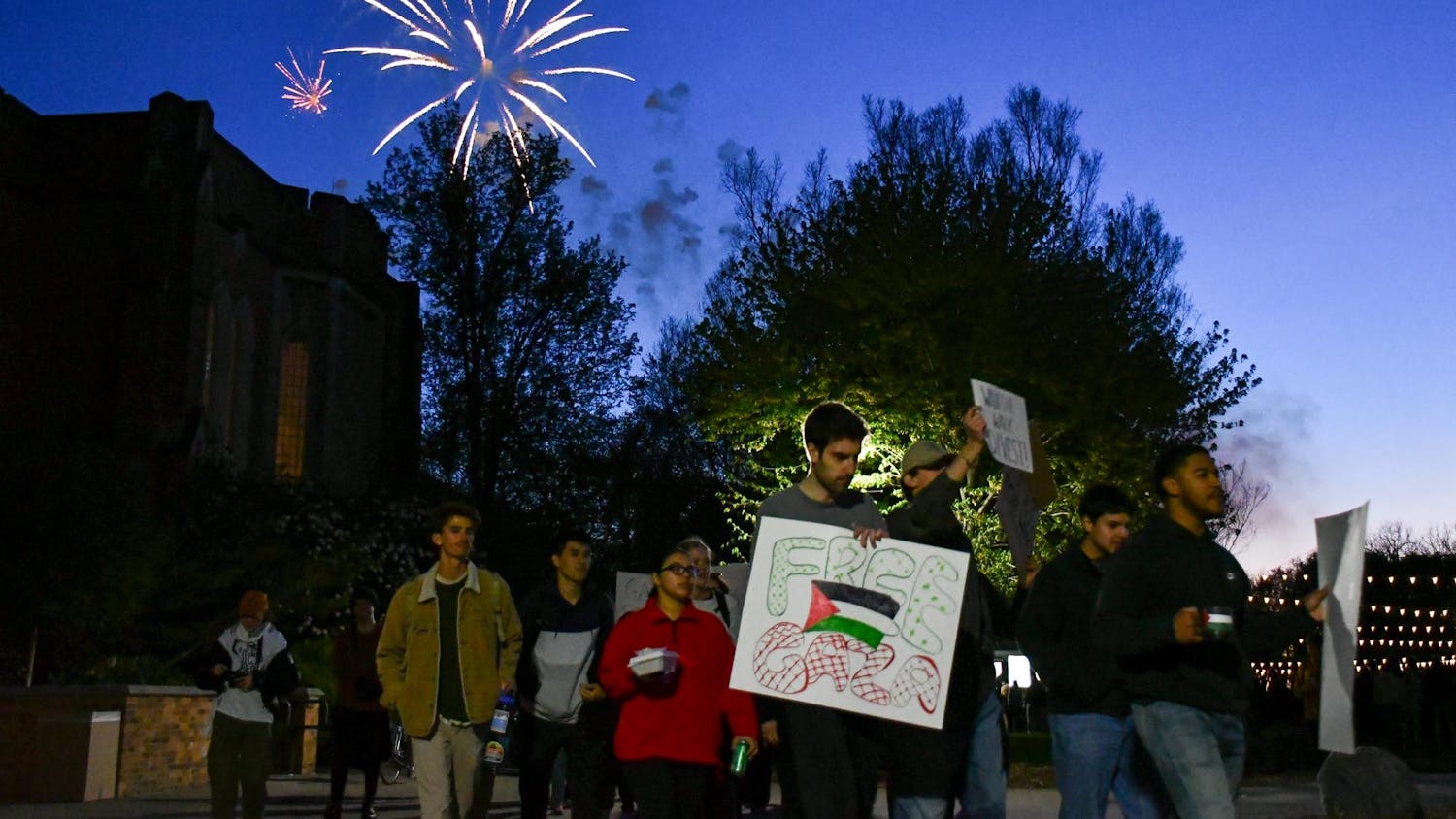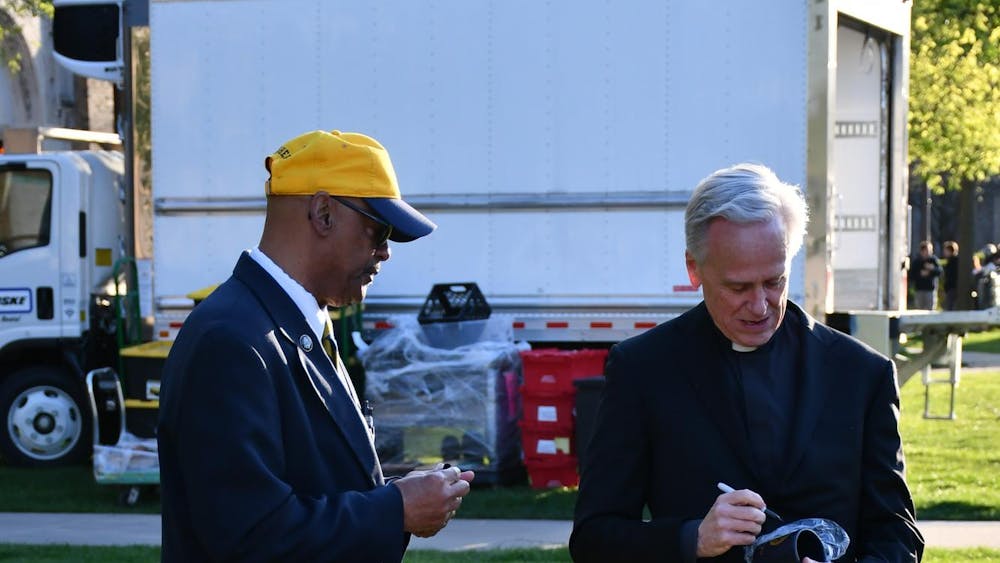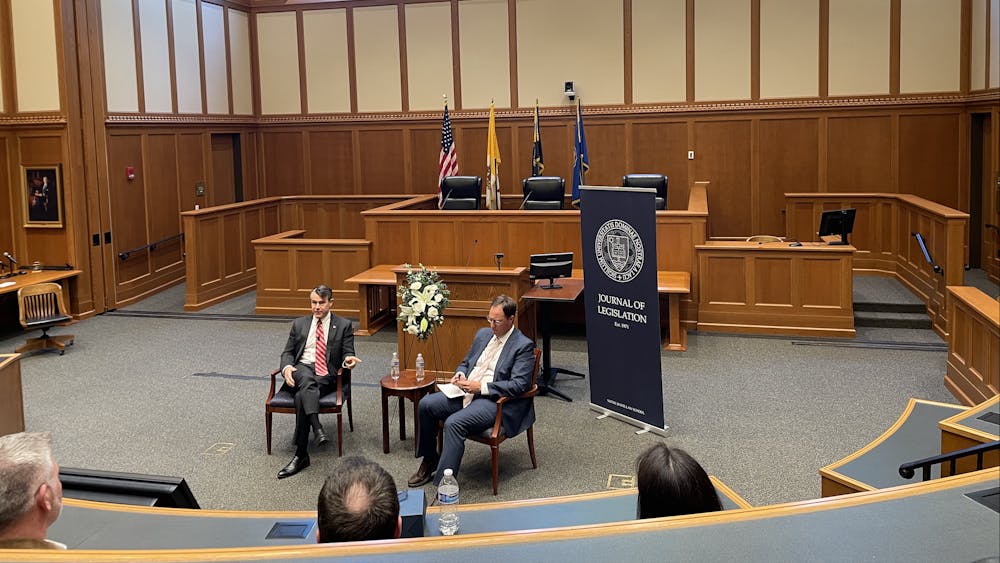Pope Francis asked, and Saint Mary’s delivered — literally.
In the fall of 2013, 10 Saint Mary’s students, the Office of Campus Ministry and the Center for Spirituality (CFS) came together to discuss ways in which the Catholic Church could better reach young women around the world. Together, the group came to one conclusion: write to Pope Francis.

Photo courtesy of L'Osservatore Romano
In August 2014, the “Voices of Young Catholic Women” project was underway, Groppe said. The College extended a national invitation to young women to write to Pope Francis to more than 700 members of the Catholic Campus Ministry Association. The invitation was also extended to Saint Mary’s alumnae, Catholic parishes in the diocese of Fort Wayne-South Bend, Catholic high schools with which Saint Mary’s has connections through the College’s recruiting network, team leaders of the Fellowship of Catholic University Students (FOCUS) and Catholic web media.
The Project
Following the national invitation, the project’s team compiled the letters, poems and other forms of creative expression into a binder for Pope Francis as they were sent to the College, Groppe said.
The responses addressed four main questions, including: what is cherished about the Catholic tradition, what it is like to be a young woman today, how young women can contribute their gifts to serve the Church’s mission and what other ways young women can support one another’s return to the Church, if disconnected, Groppe said.
College president Carol Ann Mooney said the project ties in with the Saint Mary’s mission “about as clearly as anything does.”
“We are concerned at Saint Mary’s not simply with, of course, the academic and intellectual development of our students, but also their moral, social and spiritual development. That’s our philosophy,” Mooney said. “This project is not just about Saint Mary’s or our students, but it is more about our Church and how it can better reach out to young women and keep them close, well-served, sustained and nourished by the Church.”
Kristen Millar, a senior and active participant in Campus Ministry, said she was first asked to help with the project last year, and agreed to help without any idea of what it would turn into.
“As I met with [members of the CFS], we went over some of the articles that spurred this project — about Millennials leaving the Church and the problems young women face today — and it was shocking for me to discover all of this because I honestly didn’t know,” Millar said. “I felt as though I’ve been sheltered from the need that exists in the Church to re-inspire young women in their faiths.”
One of the articles that prompted the project was America magazine’s 2012 article titled “A Lost Generation?” about fewer women in the United States practicing their faith, Groppe said.
After reading the article, the group knew something needed to be done, Millar said.
“At a time when many have left the Church, letters that give expression to the beauty, truth and goodness that young women do find in Catholicism can make an important contribution to the New Evangelization,” Groppe said. “Letters may also generate ideas about ways in which the Church could strengthen its support for young women amidst the many challenges they face to their baptismal holiness and human dignity, including epidemic levels of sexual violence and a media culture that degrades women. The intent of this project is constructive and hopeful.”
The CFS received 225 letters, including several poems, some prayers and a number of drawings and works of art, Groppe said. Most notably, students at Saint Ursula Academy in Cincinnati designed a handmade pink and red satin stole for Pope Francis.
Though most of the letters have been kept confidential, the letters expressed love for the Church and the Pope, but also included concerns about today’s secular culture, which often objectifies women, director of media relations Gwen O’Brien said.
“Some writers shared private sorrows, like that of sexual assault,” O’Brien said. “Others recognized the problem and ideas on how to address it.”
Delivering the Letters to Pope Francis
Over Thanksgiving break, Bishop Kevin Rhoades, of the Diocese of Fort Wayne-South Bend, Mooney, Millar and alumna Grace Urankar, (class of 2014) traveled to Rome to deliver the letters Nov. 26 at the weekly papal audience.
Urankar said the weight of the project did not hit her until she literally found herself carrying the bag with the large binder containing the 225 letters through the metal detector at the Vatican.
“To physically carry them reminded me of the old belief ‘strength in numbers.’ It means so much to me that other young Catholic women appreciated our mission and united with us in letter writing,” Urankar said. “With so many voices represented, how could we not be heard?”
After the papal audience, Rhoades introduced Millar and Mooney to Pope Francis in Spanish, and all were able to shake Pope Francis’ hand as they delivered the binder and stole.
“I presented the stole from Saint Ursula’s, and then President Mooney gave Pope Francis the binder and said that the letters contained the joys, hopes, griefs and sorrows of young women from the millennial generation,” Millar said. “He shook both of our hands and said ‘Please pray for me, I need the prayers,’ which was incredibly moving and humbling to hear.
“The very day before, Pope Francis was in France, and the next day he was leaving for Turkey, so it just shows you how much of an effort he is making to reach different communities and address different issues,” Millar said. “He’s a universal symbol for the universal Church, and we were honored to be able to present him with a national symbol — the letters.”
Mooney said the experience of delivering the letters was wholly thrilling.
“It’s not only thrilling to go to Rome, and it’s certainly thrilling to actually talk to the Pope, but it was truly thrilling to feel like we were there doing something that was really important,” Mooney said.
Besides attending the papal audience and meeting Pope Francis, the group attended a Mass offered by Bishop Rhoades and had dinner with the students studying in the College’s Rome study abroad program, Millar said.
The group also toured the Vatican Museums and Sistine Chapel, led by Rome program professor Harula Economopoulos, and they visited the sites of historic Rome, such as the Colosseum and Pantheon.
“One night at dinner, President Mooney, her husband, George, and Grace and I sat down and had a really good conversation about the project and the Pope and how we need to remember that the pope is human too,” Millar said. “A lot of times we think of him as a more distant figure, when in actuality he is going through the same trials of being a human like we are, and he has the same joys and hopes and fears.
“When we saw him in the audience, he was so charismatic and gets so much joy out of being with the people. You can tell he wants to be in the community helping people and knowing people. He stays in the crowd as long as he can, even if he’s in his ‘Pope mobile.’
"I am just grateful to be able to do my part in answering his call to young women," Millar said.
'Together, we can do even more'
With the letters delivered, the project’s team has since returned to the United States and hopes the idea behind the project will continue to be discussed in the Church and beyond, Millar said.
One of the group's more modest hopes, expressed by Mooney, Millar and Urankar, is simply for the letters to be read.
“Some young women poured their hearts out in the pages of those letters, so what one hopes is not only that they are read — and I trust they will be — but that with the Holy Spirit, there’s some realization of unmet needs and how the Church can work to meet them,” Mooney said.
Urankar said she believes Pope Francis will read and hold the letters’ intentions in his heart.
“It is a challenging time and culture for us as young American Catholic women, but we are strong, committed and prepared to build the kingdom of God,” Urankar said. “I hope Pope Francis realizes this through our letters, and I hope anyone who has witnessed this project knows the same.”
In regards to the project’s development, Mooney said she was impressed by the enthusiasm of the students and their courage to aim for the top from the very beginning.
“Quite often, one loses that optimism and that belief that they have the ability to make change,” Mooney said. “We all need to keep that belief in ourselves alive. The optimism and enthusiasm that fueled this project is very important for everybody to keep.”
The project will continue to manifest, Millar said, if women advocate for other women in our daily lives in all situations, as pressures build from society to remain faithful.
“It’s important that women see their roles in the Church and within one another’s lives as vital and necessary, because they are,” Millar said. “I have had challenges in my faith and how to live it out, but ultimately I was able to make this trip because of the women mentors in my life. That’s the most important aspect for me.
“To have seen the progression of this project was amazing, and we were able to receive an outpouring of messages of women in the United States saying, ‘This is awesome,’ and ‘This is so needed,’ which shows that this needs to be an ongoing conversation to bring about change.
“We all just need to remember that although you may be one person, you can do so much, and together, we can do even more.”













